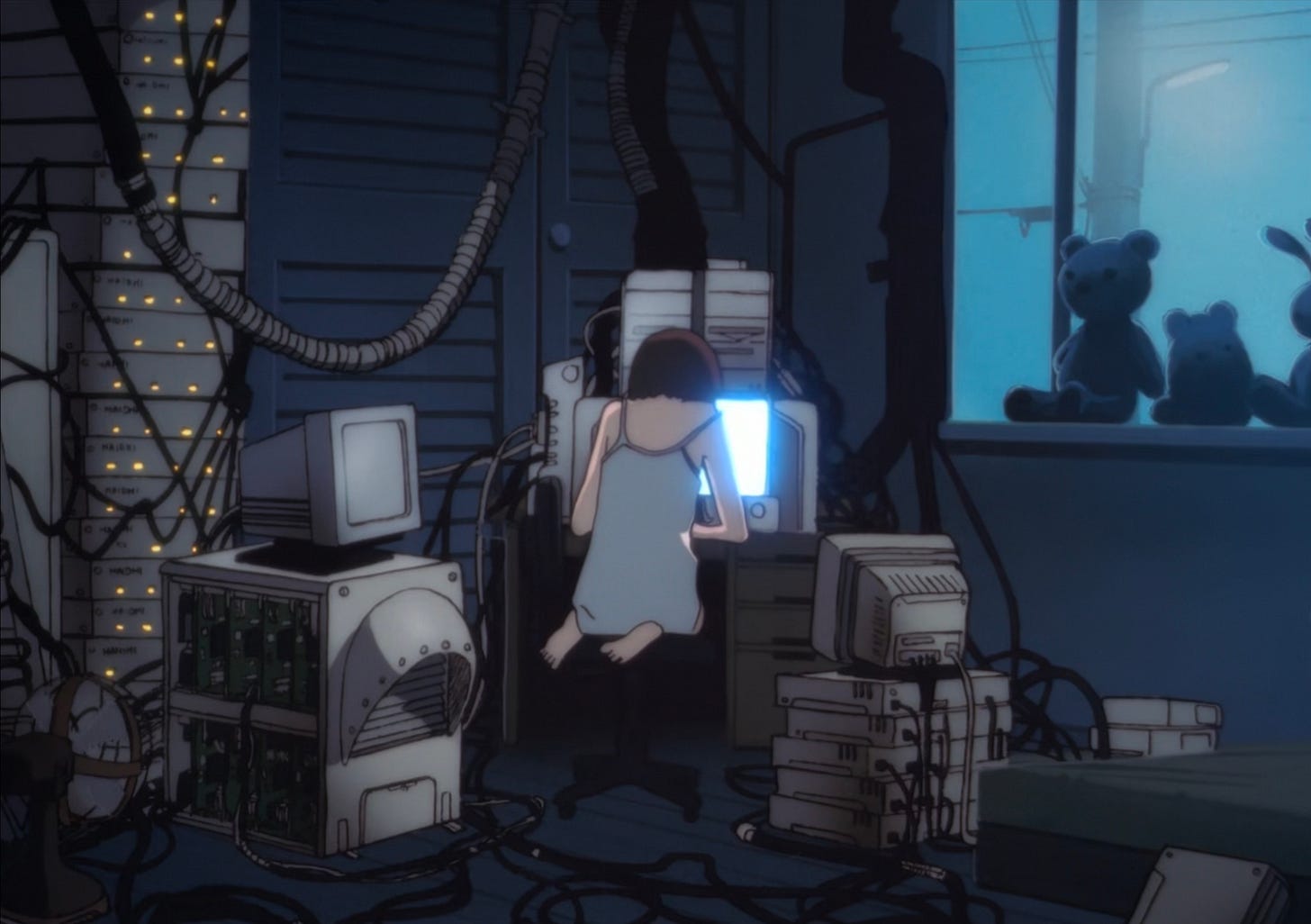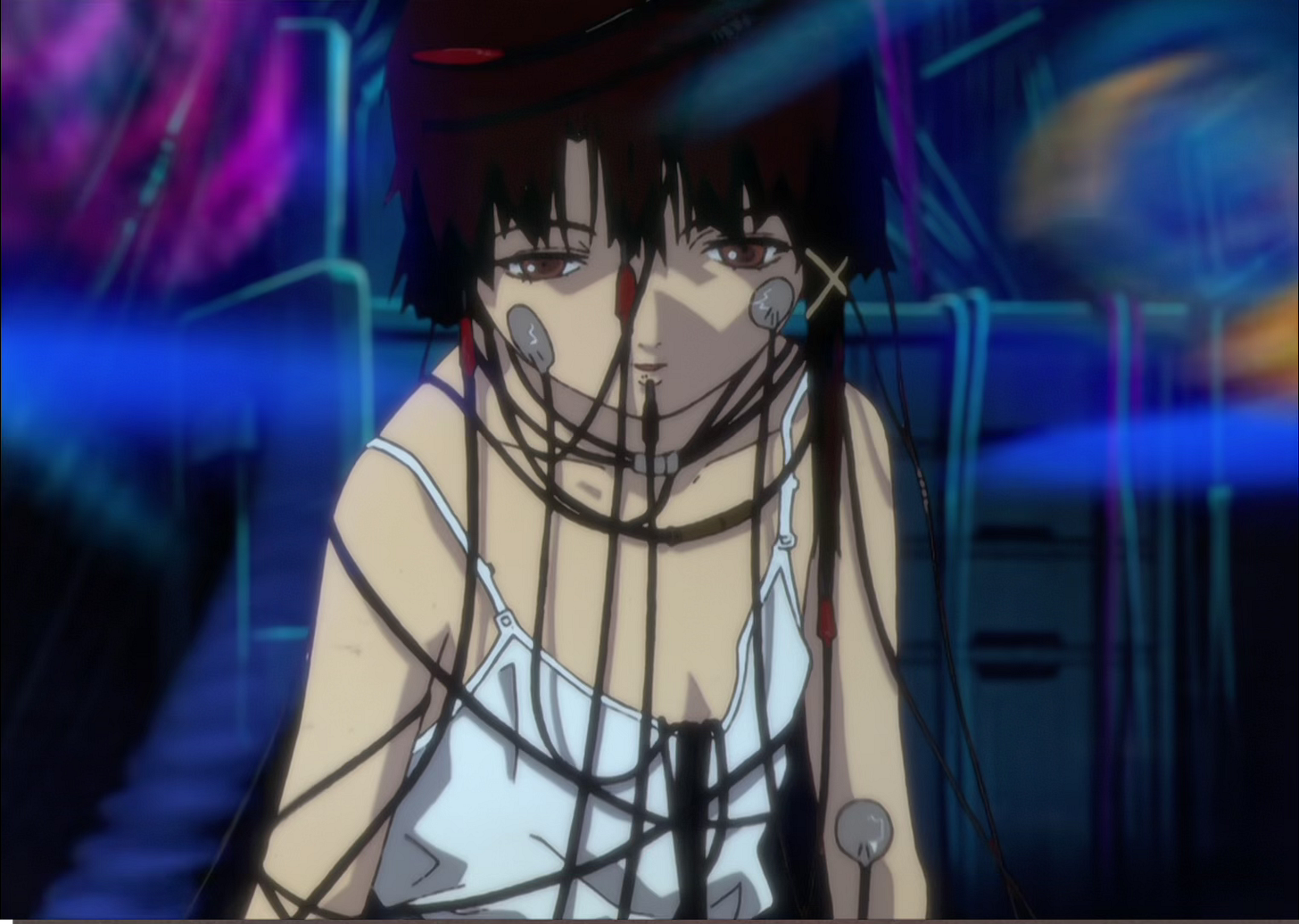004: Girlbots II
Part 2 of 2 on The Ginny Suite, the TESCREAL bundle, “Serial Experiments Lain” and other cyberfeminist considerations.
This is Part Two. If you have not already, read Part One before you continue. And make sure you’re subscribed so you never miss an essay. — Michelle 🩸
When a woman is brought up to be everything to everyone, she knows firsthand what it’s like not to have a solid sense of self. In her 1994 lecture, “Seduced and Abandoned,” Sadie Plant’s argued that because women are already so practiced in flexibility and decentered identities, they have an advantage in this increasingly digitized world. But this idea that women are somehow optimized for digitality makes me anxious. Being a digital subject sucks: I hate the ads, the need for profile pics, the endless passwords, the surveillance and data mining.
However, I am attracted to Plant’s “notion of the spread-out, sense of post-self not bounded by the skin.” An expansion of the idea of the self that opens the door to an understanding of identity “which had previously never been acceptable, thinkable or conceivable to Western patriarchal culture.” I can even relate to her claim that “woman has always been somehow in proximity to this in our emerging notion of a dispersed decentered organism.” I recognize in myself this instinct to lean into the fragmentedness, that post-self feeling of being nobody and somebody at the same time. I can also admit that these are experiences I almost exclusively have when interfacing with technology: reading a book, typing up an essay, watching a video. Moments where I tend to feel my most ~feminine.~ But is being optimized for life online — at least the version of it we have today — as liberating as we’d like to think it is?
Lain knows little to nothing about computers at the start of the show. She took the same basic computer science class as her peers and that was it. Whatever skills she needs to get deeper into The Wired, she learns along the way. Or so the viewer has to assume. Because Lain’s connection to technology can be seen as something she knows intuitively, through her body more than her mind. As if she is finding something within herself instead of outside of herself. As if, as a woman-in-the-making, she is growing stronger in her ability to connect and move through a digital world.
The Wired reminds me of the psychoanalytic concept of the archaic mother, the original matrix. In her famous treatise on the monstrous-feminine, Barbara Creed describes the archaic mother as “primordial abyss, the point of origin and of end.”1 A pre-Oedipal figure, the archaic mother is buried in the depths of time, an amorphous being that precedes the self. In cyberpunk narratives, the World Wide Web is depicted as this great originating consciousness, this mass of connectivity from which discrete units of being — people or software — emerge. According to Plant, cyberpunk always “imagines women as having some implicit prior connection to the matrix.” Merriam Webster’s Dictionary defines “matrix” as “an array of circuit elements (such as diodes and transistors) for performing a specific function.” More broadly, a matrix is defined as “something within or from which something else originates, develops or takes form” and it’s an etymological descendant of the Latin word for female breeder or womb.
As Lain’s room grows crowded with hardware, water accumulates on the floor and sloshes around like amniotic fluid. Eventually, Lain jacks-in completely: cables wrapped around her limbs, electrodes stuck to her chest and ears, wires clipped to her mouth. She is fully re-integrated to her originating environment. It’s tempting to think that Lain’s connection to technology is a product of her privileged access to some archaic matrix. That her technological abilities bypass the brain and interface to benefit from a flesh-based immediacy native to Lain’s female form. That it’s no longer a girl and a machine but contact between self-same forms.
But a woman’s power over a machine is too easily depicted as an accident of the flesh or some primordial connection. I’m troubled by how easily even the most inventive representations of machines and the feminine slide into these old habits of separating women from their technological prowess. The girl as a portal to the primordial other inside the machine insists on imagining her as, once again, an idealized digital subject. If her relationship to technology is carnal, intuitive, unmediated, it can also be read as less technical. Technology — “the practical application of knowledge” — continues to elude the feminine.
I think back to Lisa Nakamura’s Digitizing Race, where she describes how pop culture can only imagine specific relationships between people and technology, ones that repeatedly fall prey to the same tired stereotypes. In films like The Matrix and Minority Report, “white users enjoy a privileged relationship with digital networked interfaces, either eschewing the use of the interface altogether or interacting with it sans keyboard, mouse and other hardware devices and instead using gestural computing.” Elsewhere, she observes how “the persistent envisioning of the pregnant female body as a vessel (the umbilical cord is painstakingly deleted from most photographic images of fetuses, thereby emphasizing its existence separately from the woman’s body) echoes an older cyberutopian notion of the body or ‘meat’ as a disposable package for what really counts: the mind.”2 The body, especially if racialized or gendered, recurringly appears as something to be transcended, surpassed and left-behind.
Nakamura explains how in movies like The Matrix, “race itself [is marked] as an essential quality of ‘being real,’ or being human” when compared to whites, “who envision and often represent themselves as having no race and no culture.”3 A familiar hierarchy once again takes shape: At the bottom we find the gendered and racialized with their realness and intuition, their noble humanity and technical regressiveness. At the top we have white men, who float above culture as masters of technology, closer to transcending than the rest of us.
In true cyberpunk fashion, “Serial Experiments Lain” (🔗) contends with the allure of transhumanism, a belief that the human condition should be improved by the proliferation of advanced technologies aimed at optimizing our cognition and longevity. In the fifth episode we meet “God,” a man convinced humanity has hit an evolutionary standstill that can only be overcome with the use of machines. “It is no longer necessary to remain a wretched human being,” he tells Lain. “Mankind has finally created an exit whereby he may escape.” In this case, it’s The Wired. Unconvinced, Plant calls cyberpunk’s obsession with transcendence through technology a continuation of “the great dream of Western patriarchal culture: the body as metaphor, finally removed from all its visceral activity, its blood and guts and all the messy stuff that man would always have rathered left behind.”
A paper published earlier this year names and describes the “TESCREAL bundle,” in an effort to dissect the schools of thought driving the current race to build Artificial General Intelligence (AGI). The bundle comprises a range of diverging ideologies that insist AGI is either necessary or inevitable, and that humanity will have to either embrace or succumb to in order to survive. When it comes to the human and environmental cost of accelerating AGI, TESCREALists are quick to justify the millions of calculable and otherwise preventable deaths as a necessary investment in the future of humanity.
Each ideology named in the TESCREAL bundle can trace its origin back to transhumanism, which the paper describes as a “version of second-wave eugenics that affirms the feasibility and desirability of radical human enhancement.” Like first-wave eugenicists, transhumanists believe in “improving the human stock.” However, transhumanism prefers to do so through the “technological possibilities associated with genetic engineering and biotechnology.”
According to the paper, Marc Andreseen had once included “TESCREAList” in his Twitter bio. While folks like Musk, Peter Thiel and Sam Altman are better known to align with just one of the labels contained in the TESCREAL acronym: transhumanism, Extropianism, singularitarianism, cosmism, Rationalism, Effective Altruism, and Longtermism.
In the show’s climax we learn that “God” is little more than the consciousness of researcher Eiri Masami, who uploaded himself into The Wired in order to push humanity towards its next evolutionary stage. As part of his plan to develop a network that can connect all of human consciousness without the need for devices, he created Lain, a program “designed to destroy the barrier between the Wired and the real world.”
But Lain rejects God/Masami and refuses to let him define her reality. Masami repeatedly tries to take advantage of Lain’s alienation to insist on his worldview, telling her she never had a body to begin with, that she’s destined for greater things. But she pushes back. She rejects his godliness, reminding him that there was a world before The Wired and before him that has lived and will continue to live on despite him. After Lain rejects him one last time, Masami’s disembodied voice becomes violently enfleshed, transfiguring into an exploding mess of limbs, tongues and eyes. It sucks up every piece of hardware in Lain’s room before becoming petrified under the weight of all the wires.
Plant, again: “No one, it turns out, actually escapes from the meat, instead, it’s a matter of getting caught up with it.” “God” was only deluded into thinking he could separate himself and his ambitions to transcend from the material world. He will always rely on other people, the Earth and its natural resources to sustain his illusory transcendence. Just as the TESCREALists will always rely on labor, rare earth minerals, ungodly amounts of water, heat, friction and fossil fuels to build and maintain their fantasies of the future.
In an earlier scene, Lain tried loading her Navi’s emulator into her own brain. Her body wrapped in wires and electrodes when “God” tells her it’s dangerous to take in so much information all at once. Here, we see the seeds of her defiance begin to sprout: “Am I a machine?,” she replies, pitifully. “Don’t talk to me like I’m a machine.” Lain was born as software, yet she embraces a material existence. She insists on inhabiting both the material and the digital, finding value in both the world of flesh and the world of The Wired. Because as anyone who uses the internet knows, the permeability between the digital and the material is an end unto itself. In the show’s final scene, we learn that Lain has chosen to get “caught up with it” and revel in her ability to move through the Wired and the material world. This machine chose to be a girl. 🧠
🔗 recommendations: an amazing short story (one of my all-time favorites) by Erin Taylor — “OFFICE KISS,” an animated short about computer classroom antics — a Bollywood college course syllabus + watchlist — Eternal TV’s 24/7 stream is full of wacky, niche video ephemera and experimental film. Lots of puppets, claymation, stock footage, New Age documentaries about nature and nerdy people. Think: if John Wilson ran a college TV station — Brian Merchant’s list of luddite horror films.
Barbara Creed, The Monstrous-Feminine: Film, Feminism, Psychoanalysis (1993), 17.
Lisa Nakamura, Digitizing Race: Visual Cultures of the Internet (2008), 159.
Nakamura, 104.






